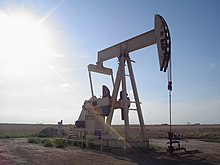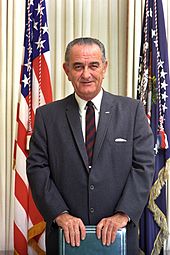The current
Texas Constitution was adopted in 1876. Like many
states, it explicitly provides for a separation of powers. The state's Bill of Rights is much larger than its
federal counterpart, and has provisions unique to Texas.
[127]
State government
Texas has a plural
executive branch system limiting the power of the governor, which is a weak executive compared to some other states. Except for the
Secretary of State, voters elect executive officers independently; thus candidates are directly answerable to the public, not the governor.
[128]
This election system has led to some executive branches split between
parties and reduced the ability of the governor to carry out a program.
When
Republican President
George W. Bush served as Texas's governor, the state had a
Democratic lieutenant governor,
Bob Bullock. The executive branch positions consist of the
Governor,
Lieutenant Governor, Comptroller of Public Accounts, Land Commissioner, Attorney General, Agriculture Commissioner, the three-member
Texas Railroad Commission, the State Board of Education, and the Secretary of State.
[128]
The
bicameral Texas Legislature consists of the
House of Representatives, with 150 members, and a
Senate, with 31 members. The
Speaker of the House leads the House, and the lieutenant governor, the Senate.
[129]
The Legislature meets in regular session biennially for just over 100
days, but the governor can call for special sessions as often as desired
(notably, the Legislature cannot call itself into session).
[130] The state's
fiscal year
spans from the previous calendar year's September 1 to the current
year's August 31. Thus, the FY 2015 dates from September 1, 2014 through
August 31, 2015.
The
judiciary of Texas
is one of the most complex in the United States, with many layers and
overlapping jurisdictions. Texas has two courts of last resort: the
Texas Supreme Court, for civil cases, and the
Texas Court of Criminal Appeals.
Except for some municipal benches, partisan elections select judges at
all levels of the judiciary; the governor fills vacancies by
appointment.
[131]
Texas is notable for its use of capital punishment, having led the
country in executions since capital punishment was reinstated in the
Gregg v. Georgia case (see
Capital punishment in Texas).
The
Texas Ranger Division of the
Texas Department of Public Safety is a
law enforcement agency with statewide
jurisdiction. Over the years, the Texas Rangers have investigated crimes ranging from murder to political corruption. They have acted as
riot
police and as detectives, protected the Texas governor, tracked down
fugitives, and functioned as a paramilitary force both for the republic
and the state. The Texas Rangers were unofficially created by
Stephen F. Austin
in 1823 and formally constituted in 1835. The Rangers were integral to
several important events of Texas history and some of the best-known
criminal cases in the history of the
Old West.
[132]
The Texas constitution defines the responsibilities of county
governments, which serve as agents of the state. What are called
commissioners court and court judges are elected to serve as the
administrative arm. Most cities in the state, those over 5,000 in
population, have
home-rule governments. The vast majority of these have charters for
council-manager forms of government, by which voters elect council members, who hire a professional city manager as operating officer.
Politics
Texas Presidential elections results[133]
| Year |
Republican |
Democratic |
| 2016 |
52.23% 4,685,047 |
43.24% 3,877,868 |
| 2012 |
57.15% 4,569,843 |
41.37% 3,308,124 |
| 2008 |
55.39% 4,479,328 |
43.63% 3,528,633 |
| 2004 |
61.09% 4,526,917 |
38.30% 2,832,704 |
| 2000 |
59.30% 3,799,639 |
38.11% 2,433,746 |
| 1996 |
48.80% 2,736,166 |
43.81% 2,459,683 |
| 1992 |
40.61% 2,496,071 |
37.11% 2,281,815 |
| 1988 |
56.01% 3,036,829 |
43.41% 2,352,748 |
| 1984 |
63.58% 3,433,428 |
36.18% 1,949,276 |
| 1980 |
55.30% 2,510,705 |
41.51% 1,881,148 |
Political history
In the 1870s, white Democrats wrested power back in the state
legislature from the biracial coalition at the end of Reconstruction. In
the early 20th century, the legislature passed bills to impose
poll taxes, followed by
white primaries; these measures effectively
disfranchised most blacks, poor whites and Mexican Americans.
[117][134] In the 1890s, 100,000 blacks voted in the state; by 1906, only 5,000 could vote.
[135] As a result, the Democratic Party dominated
Texas politics
from the turn of the century, imposing racial segregation and white
supremacy. It held power until after passage in the mid-1960s of
national civil rights legislation enforcing constitutional rights of all
citizens.
Although Texas was essentially a one-party state during this time and
the Democratic primary was viewed as "the real election," the
Democratic Party had conservative and liberal factions, which became
more pronounced after the
New Deal.
[136] Additionally, several factions of the party briefly split during the 1930s and 40s.
[136]
The state's conservative white voters began to support Republican
presidential candidates by the mid-20th century. After this period, they
supported Republicans for local and state offices as well, and most
whites became Republican Party members.
[137]
The party also attracted some minorities, but many have continued to
vote for Democratic candidates. The shift to the Republican Party is
much-attributed to the fact that the Democratic Party became
increasingly
liberal during the 20th century, and thus increasingly out-of-touch with the average Texas voter.
[138] As Texas was always a
conservative state, voters switched to the GOP, which now more closely reflected their beliefs.
[138][139] Commentators have also attributed the shift to Republican political consultant
Karl Rove, who managed numerous political campaigns in Texas in the 1980s and 90s.
[139] Other stated reasons included court-ordered redistricting and the demographic shift in relation to the
Sun Belt that favored the Republican Party and conservatism.
[126]
The
2003 Texas redistricting of Congressional districts led by Republican
Tom DeLay, was called by the
New York Times "an extreme case of partisan
gerrymandering".
[140] A group of Democratic legislators, the "
Texas Eleven", fled the state in a
quorum-busting effort to prevent the legislature from acting, but was unsuccessful.
[141]
The state had already redistricted following the 2000 census. Despite
these efforts, the legislature passed a map heavily in favor of
Republicans, based on 2000 data and ignoring the estimated nearly one
million new residents in the state since that date. Career attorneys and
analysts at the Department of Justice objected to the plan as diluting
the votes of African American and Hispanic voters, but political
appointees overrode them and approved it.
[140] Legal challenges to the redistricting reached the national
Supreme Court in the case
League of United Latin American Citizens v. Perry (2006), but the court ruled in favor of the state (and Republicans).
[142]
In the
2014 Texas elections, the
Tea Party movement made large gains, with numerous Tea Party favorites being elected into office, including
Dan Patrick as lieutenant governor,
[143][144] Ken Paxton as attorney general,
[143][145] in addition to numerous other candidates
[145] including conservative Republican
Greg Abbott as governor.
[146]
Texas politics today
Texas voters lean toward
fiscal conservatism,
while enjoying the benefits of huge federal investment in the state in
military and other facilities achieved by the power of the Solid South
in the 20th century. They also tend to have
socially conservative values.
[147][148]
Since 1980, most Texas voters have supported Republican presidential candidates. In 2000 and 2004, Republican
George W. Bush won Texas with 60.1 percent of the vote, partly due to his "favorite son" status as a former governor of the state.
John McCain won the state in
2008,
but with a smaller margin of victory compared to Bush at 55 percent of
the vote. Austin, Dallas, Houston, and San Antonio consistently lean
Democratic in both local and statewide elections.
Residents of counties along the
Rio Grande closer to the
Mexico-United States border,
where there are many Latino residents, generally vote for Democratic
Party candidates, while most other rural and suburban areas of Texas
have shifted to voting for Republican Party candidates.
[149][150]
As of the
general elections of 2014, a large majority of the members of Texas's
U.S. House delegation are
Republican, along with both
U.S. Senators. In the
114th United States Congress, of the 36
Congressional districts in Texas, 25 are held by Republicans and 11 by Democrats. Texas's Senators are
John Cornyn and
Ted Cruz.
Since 1994, Texans have not elected a Democrat to a statewide office.
The state's Democratic voters are made up primarily by liberal and
minority groups in Austin, San Antonio, Dallas, Houston, Beaumont, and El Paso, as well as minority voters in East Texas and South Texas.
| United States presidential election in Texas, 2016[151] |
| Party |
Candidate |
Running mate |
Votes |
Percentage |
Electoral votes |
|
Republican |
Donald Trump |
Mike Pence |
4,685,047 |
52.23% |
36 |
|
Democratic |
Hillary Clinton |
Tim Kaine |
3,877,868 |
43.24% |
0 |
|
Libertarian |
Gary Johnson |
William Weld |
283,492 |
3.16% |
0 |
|
Green |
Jill Stein |
Ajamu Baraka |
71,558 |
0.80% |
0 |
|
Write-in |
Various candidates |
Various candidates |
51,261 |
0.57% |
0 |
|
Republican |
John Kasich[a] |
Carly Fiorina[a] |
0 |
0.0% |
1 |
|
Libertarian |
Ron Paul[a] |
Mike Pence |
0 |
0.0% |
1 |
| Totals |
8,969,226 |
100.00% |
38 |
| Voter turnout (Voting age population) |
|
Administrative divisions
Texas has 254
counties— the most nationwide. Each county runs on
Commissioners' Court
system consisting of four elected commissioners (one from each of four
precincts in the county, roughly divided according to population) and a
county judge elected at large from the entire county. County government
runs similar to a "weak"
mayor-council system; the county judge has no veto authority, but votes along with the other commissioners.
Although Texas permits cities and counties to enter "interlocal agreements" to share services, the state does not allow
consolidated city-county governments, nor does it have
metropolitan governments. Counties are not granted
home rule
status; their powers are strictly defined by state law. The state does
not have townships— areas within a county are either incorporated or
unincorporated. Incorporated areas are part of a municipality. The
county provides limited services to unincorporated areas and to some
smaller incorporated areas. Municipalities are classified either
"general law" cities or "home rule".
[152] A municipality may elect home rule status once it exceeds 5,000 population with voter approval.
Texas also permits the creation of "special districts", which provide limited services. The most common is the
school district,
but can also include hospital districts, community college districts,
and utility districts (one utility district located near Austin was the
plaintiff in
a landmark Supreme Court case involving the Voting Rights Act).
Municipal, school district, and special district elections are
nonpartisan,
[153] though the party affiliation of a candidate may be well-known. County and state elections are partisan.
Criminal law
Texas has a reputation of very harsh criminal punishment for criminal offenses. It is one of the 32 states that practice
capital punishment, and since the
US Supreme Court allowed capital punishment to resume in 1976, 40% of all US executions have taken place in Texas.
[154] As of 2008, Texas had the 4th highest
incarceration rate in the US.
[155] Texas also has strong
self defense laws, allowing citizens to use lethal force to defend themselves, their families, or their property.
[156]











